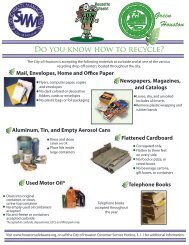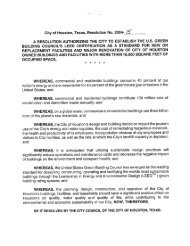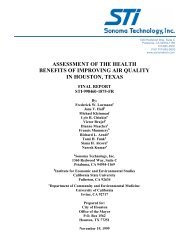A Closer Look at Air Pollution in Houston: - Green Houston
A Closer Look at Air Pollution in Houston: - Green Houston
A Closer Look at Air Pollution in Houston: - Green Houston
Create successful ePaper yourself
Turn your PDF publications into a flip-book with our unique Google optimized e-Paper software.
<strong>Houston</strong> reaches $21,701. These are neighborhoods whereresidents live on less than half of the <strong>in</strong>come of their fellow<strong>Houston</strong>ians.In Harrisburg/Manchester, 37 percent of the residentshave less than a high school educ<strong>at</strong>ion, and 32 percent fallbelow the Federal poverty level - double the r<strong>at</strong>e for the surround<strong>in</strong>gcounty. In Cl<strong>in</strong>ton Park, 27 percent have less than ahigh school educ<strong>at</strong>ion, and the same percent fall below thepoverty level. The residents <strong>in</strong> these neighborhoods are alsosegreg<strong>at</strong>ed by race or ethnicity. Cl<strong>in</strong>ton Park is over 90 percentAfrican-American. Harrisburg/Manchester is 88 percentHispanic. Further, the p<strong>at</strong>tern of land use shows pockets ofresidences surrounded by <strong>in</strong>dustrial sites, either disposallagoons for dredged m<strong>at</strong>erial from the Ship Channel <strong>at</strong> Cl<strong>in</strong>tonPark or fence l<strong>in</strong>es beh<strong>in</strong>d heavy <strong>in</strong>dustry for Harrisburg/Manchester. The conditions necessary for healthy lifestyles,economic sustenance and quality of life for residents are fewerhere than <strong>in</strong> most neighborhoods.Aside from vulnerability, there is also the question ofwhether the sources of the pollutants pos<strong>in</strong>g the highest risksare the same <strong>in</strong> East <strong>Houston</strong> as <strong>in</strong> the rest of the Gre<strong>at</strong>er<strong>Houston</strong> Area. As it turns out, they are typically not the same.For East <strong>Houston</strong>, NATA <strong>at</strong>tributes the ambient modeled concentr<strong>at</strong>ionsof 7 of the top 12 pollutants to po<strong>in</strong>t sources; for theGre<strong>at</strong>er <strong>Houston</strong> Area, this number drops to 3. East <strong>Houston</strong>had no pollutants where area sources dom<strong>in</strong><strong>at</strong>ed among those<strong>in</strong> the def<strong>in</strong>ite risk c<strong>at</strong>egory; Gre<strong>at</strong>er <strong>Houston</strong> had 1. Betweenon-road and non-road mobile sources, the most dram<strong>at</strong>ic differenceis for diesel particul<strong>at</strong>e m<strong>at</strong>ter: over 90 percent of theambient modeled concentr<strong>at</strong>ions <strong>in</strong> East <strong>Houston</strong> neighborhoodsare <strong>at</strong>tributed to non-road mobile sources compared tothree-quarters of the total <strong>in</strong> Gre<strong>at</strong>er <strong>Houston</strong>.The map <strong>in</strong> Appendix 7 also shows several monitor<strong>in</strong>gsites where one or more of the pollutants <strong>in</strong> the def<strong>in</strong>ite risk c<strong>at</strong>egoryare currently be<strong>in</strong>g measured (The supplemental TableA8.1 <strong>in</strong> Appendix 8 shows which pollutants are monitored).S<strong>in</strong>ce these sites record ambient concentr<strong>at</strong>ions, the levelspresent <strong>in</strong> any given census tract cannot be accur<strong>at</strong>elydeterm<strong>in</strong>ed without consider<strong>in</strong>g factors such as w<strong>in</strong>d directionand temper<strong>at</strong>ure. Nonetheless, the sites th<strong>at</strong> appear <strong>in</strong>Appendix 7 recorded annual average concentr<strong>at</strong>ions for2004 th<strong>at</strong> exceeded our health value thresholds for pos<strong>in</strong>gdef<strong>in</strong>ite health risks. Three of these sites are conta<strong>in</strong>ed <strong>in</strong> oradjacent to the neighborhoods th<strong>at</strong> also had the largest numberof def<strong>in</strong>ite risk pollutants, based on NATA modeled estim<strong>at</strong>esfor 1999.In sum, East <strong>Houston</strong> neighborhoods th<strong>at</strong> face a numberof vulnerabilities based on their marg<strong>in</strong>al social and economicstand<strong>in</strong>g also carry a heavier burden of health risks frombre<strong>at</strong>h<strong>in</strong>g pollutants <strong>in</strong> their air. They tend to be loc<strong>at</strong>ed closerto major po<strong>in</strong>t sources than most other neighborhoods <strong>in</strong> theGre<strong>at</strong>er <strong>Houston</strong> area and to be nearer to major transport<strong>at</strong>ioncorridors. The burden of these risks taken together poses specialneeds <strong>in</strong> these neighborhoods.CONCLUSIONS AND RECOMMENDATIONSSubstantial efforts have been devoted over the years toscrut<strong>in</strong>iz<strong>in</strong>g air pollution levels <strong>in</strong> <strong>Houston</strong>, and considerableresources have been expended on mitig<strong>at</strong>ion measures.Although the success of these endeavors is difficult to quantify,it appears th<strong>at</strong> levels of some air pollutants, like ozone, havedecreased s<strong>in</strong>ce the early 1980s even though <strong>Houston</strong>'s popul<strong>at</strong>ion,economy, and traffic have grown steadily. Much of theprogress over the past 35 years can be <strong>at</strong>tributed to regul<strong>at</strong>orycontrols mand<strong>at</strong>ed by the 1970 Clean <strong>Air</strong> Act and subsequentamendments. But air quality improvements <strong>in</strong> <strong>Houston</strong> appearto have slowed or even stalled recently, and there is legitim<strong>at</strong>econcern th<strong>at</strong> m<strong>at</strong>ters will only get worse. A critical first step <strong>in</strong>f<strong>in</strong>d<strong>in</strong>g cost-effective solutions is to identify those airborne pollutantsth<strong>at</strong> represent the most serious health risks so th<strong>at</strong> controlstr<strong>at</strong>egies can be designed to focus on the worst risks first.Historically, federal and st<strong>at</strong>e regul<strong>at</strong>ory efforts have beendirected primarily toward meet<strong>in</strong>g N<strong>at</strong>ional Ambient <strong>Air</strong> QualityStandards for the 6 criteria pollutants commonly found <strong>in</strong> urbanair. Most of the <strong>at</strong>tention <strong>in</strong> <strong>Houston</strong> has been on ozone -- theonly criteria pollutant for which the city is not <strong>in</strong> compliance --because of harsh penalties mand<strong>at</strong>ed by the Clean <strong>Air</strong> Act ifambient ozone concentr<strong>at</strong>ions do not meet the 8-hour standardby June 2010 (an unlikely prospect). There is also a grow<strong>in</strong>gbody of evidence <strong>in</strong>dic<strong>at</strong><strong>in</strong>g th<strong>at</strong> f<strong>in</strong>e particul<strong>at</strong>e m<strong>at</strong>ter causessignificant health effects <strong>at</strong> ambient concentr<strong>at</strong>ions below the23







